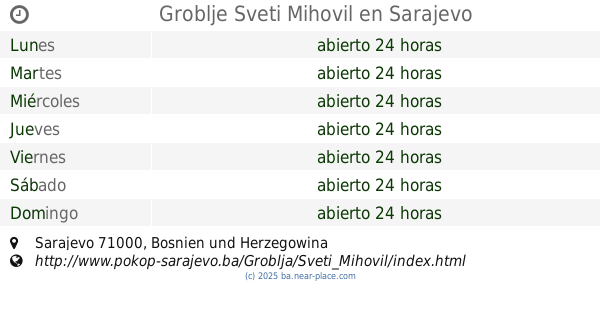abierto
🕗 horarios
| Lunes | abierto 24 horas | |||||
| Martes | abierto 24 horas | |||||
| Miércoles | abierto 24 horas | |||||
| Jueves | abierto 24 horas | |||||
| Viernes | abierto 24 horas | |||||
| Sábado | abierto 24 horas | |||||
| Domingo | abierto 24 horas | |||||
bb, Patriotske lige, 71000, Sarajevo, Kanton Sarajevo, BA Bosnia and Herzegovina
contactos teléfono: +387
sitio web: www.pokop-sarajevo.ba
mapa e indicacionesLatitude: 43.8665924, Longitude: 18.4108525






Aleksandar Lakić
::During the last century this region saw power change hands many times and, as a result, a number of Sarajevo monuments which had been erected by an earlier power were often the first things demolished by a new regime. Prime examples of this are some monuments that were erected to memorialize the Sarajevo Assassination on June 28, 1914, when Gavrilo Princip shot the Austrian Archduke Franz Ferdinand and his pregnant wife Sophie. Princip was a member of Young Bosnia, a controversial political-revolutionary youth organization which, with the help of the Serbian terrorist organization, Black Hand, fought against Austro-Hungarian occupation and supported the annexation of BiH by the Kingdom of Serbia. Young Bosnia would have probably remained an obscure organization, had it not carried out its infamous plot, which was due more to a string of coincidences than to ability. Austro-Hungarian police quickly arrested nearly all of the culprits and sentenced them to death, but those who were too young, by Austro-Hungarian law, were given long prison sentences. Princip ended up serving time in a fortress in Terezin in the Czech Republic, where he died of TB on April 28, 1918. The assassination triggered World War I, and BiH was annexed by a new state with a Serbian Monarch at its head. Those who had participated became national heroes in the newly-founded Kingdom of Serbs, Croats and Slovenes, later the Kingdom of Yugoslavia. The assassination occurred on the Orthodox holiday, Vidovdan (St. Vitus’ Day), so the perpetrators were called the “Vidovdan Heroes”. The post-mortem remains of the Vidovdan Heroes were collected from all of the prisons in the countries that had been part of the Austro-Hungarian Empire, where they had been incarcerated. They were later buried in a common grave in Sarajevo on July 7, 1920. Exactly 19 years later, the Chapel of the Holy Archangel was built and dedicated to them. The Chapel was built in Koševo, in the old Orthodox cemetery of Archangel Michael, at the behest of the Patriarchy of the Orthodox Church in Sarajevo. It was designed by Serbian architect and WWI volunteer pilot, Aleksandar Deroko, who had socialized with Picasso and Le Corbusier while studying in Paris. Above the portal are inscribed the names of: Gavrilo Princip, Bogdan Žerajić, Nedeljko Čabrinović, Danilo Ilić, Trifko Grabež, Nedeljko Čubrilović, Mihajlo-Miško Jovanović, Mitar Kerović, Neđo Kerović, Jakov Milović and Marko Perin. There are also verses by the Montenegrin poet, Petar II Petrović Njegoš: “Blessed are those who live forever, they were not born in vain.” While the Vidovdan Heroes found their last resting place in Sarajevo, Franz Ferdinand and his wife Sophie were buried in tombs in Artstetten Castle in Austria. It is not widely known that the Chapel also preserves and keeps alive the memory of a century-old Orthodox cemetery, which used to be where the BiH Parliament is located today, in Donja Hiseta. Even by the 1930s, the cemetery was quite neglected, so the Patriarchy decided to use some of the tombstones in the Chapel’s construction. Today, one can see the old tombstones that were used, as well as the names, written in old Cyrillic, of those who have long been forgotten.